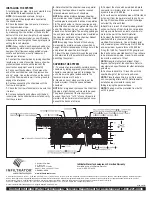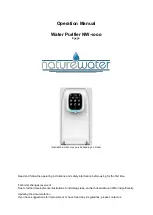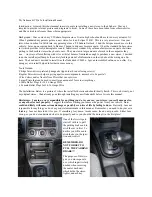
3. Compact the stone with a walk-behind plate
compactor or vibratory roller, not to exceed the
dynamic force of 10,000 lbs.
4. Cover the entire installation area with filter fabric
by taking it from the perimeter and laying it over
the top of the stone. Make sure that it overlaps
onto itself by at least 2 feet.
5. Backfill in a 6-inch lift of well-graded,granular
solid over the top of the filter fabric. Large rocks
and organic matter such as roots, stumps, etc.,
must not be part of the backfill material.
6. Compact the backfill after this and each
additional lift to a minimum of 95% of the
modified Proctor density. Use a vibratory roller
with maximum gross vehicle weight of 12,000 lbs
and a maximum dynamic force of 20,000 lbs.
7. Lay ISI 14,000 or Tensar BX1100 geogrid over
the 6 inches of compacted backfill. If two rolls are
to be placed side-by-side, or end-to-end, overlap
them with a minimum of 2 feet.
NOTE: Geogrid must extend at least 5 feet
beyond the footprint of the chambers. Refer to
manufacture’s specifications for other installation
guidelines.
8. Continue to backfill in 12-inch lifts until the
specified height of the system is achieved.
NOTE: Place the backfill in 6-inch lifts in sandy
soil, compacting after each lift. Refer to special
installation requirements for sandy soil.
9. Begin laying the pavement base.
NOTE: The bed must be protected from traffic
until it is paved.
Contact Infiltrator Water Technologies’ Services Department for assistance at 1-800-221-4436
4 Business Park Road
P.O. Box 768
Old Saybrook, CT 06475
860-577-7000 • Fax 860-577-7001
1-800-221-4436
www.infiltratorwater.com
U.S. Patents: 4,759,661; 5,017,041; 5,156,488; 5,336,017; 5,401,116; 5,401,459; 5,511,903; 5,716,163; 5,588,778; 5,839,844 Canadian Patents: 1,329,959; 2,004,564 Other patents pending. Infiltrator, Equalizer,
Quick4, and SideWinder are registered trademarks of Infiltrator Water Technologies. Infiltrator is a registered trademark in France. Infiltrator Water Technologies is a registered trademark in Mexico. Contour,
MicroLeaching, PolyTuff, ChamberSpacer, MultiPort, PosiLock, QuickCut, QuickPlay, SnapLock and StraightLock are trademarks of Infiltrator Water Technologies
PolyLok is a trademark of PolyLok, Inc. TUF-TITE is a registered trademark of TUF-TITE, INC. Ultra-Rib is a trademark of IPEX Inc.
© 2016 Infiltrator Water Technologies, LLC. All rights reserved. Printed in U.S.A.
A100 0416ISI
INSTALLING THE SYSTEM
1. Install piping per plan. A d-box or manifold may
be installed if allowed/required by law.
NOTE: For pressurized systems, it may be
easier to install the piping before constructing
the chamber bed.
2. Check the header pipe to be sure it is level or
has the prescribed slope.
3. Set the invert elevation at the appropriate height
by measuring from the bottom of the bed to the
bottom of the inlet. Invert height will vary depend-
ing on which chamber model is used. PRecisely
measure the invert height on the end plate prior to
setting the invert elevation.
NOTE: Scour controls, such as splash pads, may
be required by state/county regulations or by the
designer if inlet flows exceed specified volume.
Locate and install scour control measures if
required per site plan.
4. Construct the chamber bed by joining chambers
length-wise in rows (if possible, be sure chamber
placement does not exceed the reach of the
construction equipment used to place fill).
5. To connect the chambers, lift and place the
end of the next chamber onto the previous one
at a 45° angle. Line up the notches on the center
end of the chamber and lower it to the ground to
engage the interlocks.
6. Continue connecting the chambers until the
first row is completed.
7. Check the first row of chambers to be sure that
it is level.
8. Continue connecting chambers until the bed
is complete. As the chambers are installed, verify
that they are level.
9. Determine that the chamber rows are parallel
following the steps above. Keep the required
istance between each row of chambers.
NOTE: Separation distance between chamber
rows varies per code. If possible, Infiltrator Water
Technologies recommends 6 inches of separation.
10. The last chamber in the row requires an end
plate. Attached a closed end plate onto the outlet
end of the chamber. Do not cut an opening in the
closed or outlet end plate. The existing opening on
the end plate must face outward when installed on
the closed or outlet end of the chamber. Repeat
this step for each row in the bed.
NOTE: Lopping the outlet end of the bed may
be required by state/local code or specified by
design. Infiltrator recommends drilling a hole in the
end plate at the specified invert height.
11. Insert the loop manifold through the end plate
and determine that the manifold is level before
backfilling the system.
COVERING THE SYSTEM
1. To ensure structural stability, carefully anchor
chambers by ladling approved gravel between the
chamber rows making sure not to dislodge the
units. Be sure the gravel extends above the
louvers a minimum of 2 inches.
2. Place 6 inches of stone over the top of the
chamber system, filling the space between
chambers.
NOTE: For a large bed that cannot be filled from
the sides, a light-tracked vehicle must be used.
The ground pressure of the tracks must not
exceed 10 psi for 6” to 12” of cover. Be sure to
maintain a 6 inch minimum of compacted cover
beneath the tracks at all times.
Infiltrator Water Technologies, LLC Limited Warranty
Available at: www.infiltratorwater.com
or call 1-800-221-4436




















